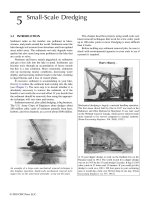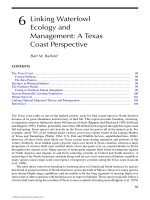Business and society ethics sustainability and stakeholder management 9e chapter 6
Bạn đang xem bản rút gọn của tài liệu. Xem và tải ngay bản đầy đủ của tài liệu tại đây (1.87 MB, 44 trang )
© 2015 Cengage Learning
1
Chapter 6
Issue, Risk
and Crisis
Management
© 2015 Cengage Learning
2
Learning Outcomes
1. Distinguish between issue management, risk
management, and crisis management.
2. Identify and briefly explain the stages in the issue
management process.
3. Describe the major categories of risk and some of the
factors that have characterized risk management in
actual practice.
4. Define a crisis and identify the four crisis stages.
5. List and discuss the major stages or steps involved in
managing business crises.
© 2015 Cengage Learning
3
Chapter Outline
• The Relationship Between Issue, Risk, and
Crisis Management
• Issue Management
• Risk Management
• Crisis Management
• Summary
© 2015 Cengage Learning
4
Issue, Risk & Crisis Management (1 of 2)
•
•
•
The World Health Organization declared the
China dairy industry scandal to be one of the
largest food-safety crises in recent history.
Nearly 300 people became sick, and several
infants died due to tainted infant formula and
food products.
Several causes of the crisis included farmers
using a lower grade of feed, distributors
adding melamine to boost protein content,
and dairies, and US firms distributing the
tainted milk, or using its contaminated
ingredients, and government cutting food
inspections.
© 2015 Cengage Learning
5
Issue, Risk & Crisis Management (2 of 2)
•
•
•
•
•
With little government oversight, the
consumer is forced to rely on businesses to
act responsibly.
But such tragedies, and the financial scandals
of many corporations, continue to erode
consumer trust in businesses.
Major external social events not caused by
business also affect businesses, and firms
must prepare to deal with them.
No company is immune to the threat of a
crisis, but few prepare.
Managerial decision-making processes should
include Issue Management, Risk
Management, and Crisis Management.
© 2015 Cengage Learning
6
Relationships Between Issue,
Risk, and Crisis Management (1 of 2)
•
Differentiating between these 3 is difficult.
Many product managers cannot differentiate
between “risks” and “issues,” which has led
them to be labeled the Siamese twins of public
relations.
•
The Issue Management Council definitions:
•
Issue – a gap between a firm’s actions and
stakeholder expectations
•
Risk – a potential issue that may or may not
occur
•
Crisis – an issue that has escalated to a critical
state © 2015 Cengage Learning
7
Relationships Between Issue,
Risk, and Crisis Management (2 of 2)
•
Goal: To be effective, issue, risk and crisis
management must close the gap between the
firms’ situation and its stakeholders’
expectations.
•
Many of the crises firms face today arise out of
issue categories they are monitoring and
prioritizing through issue management systems.
•
Risk Management may keep issues from arising
•
Effective issue management may enable the
firm to avoid a crisis, or minimize its impact, and
is vital to post-crisis management.
© 2015 Cengage Learning
8
© 2015 Cengage Learning
9
Issue Management •
•
is a process by which organizations:
•
identify issues in the stakeholder environment,
•
analyze and prioritize them in terms of their
relevance to the organization,
•
plan responses to the issues, and then
•
evaluate and monitor the results.
It is helpful to think of issue management in
connection with sustainable strategic
management process, enterprise-level
strategy, corporate public policy, and
integrated reporting.
© 2015 Cengage Learning
10
Issue Management (IM)
Two Approaches (1 of 2)
1. Conventional Approach -
•Narrowly focused.
•Issues fall within the domain of public policy or
public affairs management.
•Issues have a public policy or public affairs
orientation.
•An issue is any trend, event, controversy, or public
development that might affect the corporation.
•Issues originate in social, political, regulatory, or
judicial environments.
© 2015 Cengage Learning
11
Issue Management (IM)
Two Approaches (1 of 2)
2. Strategic Management Approach -
•Broadly inclusive.
•IM is typically the responsibility of senior line
management or strategic management staff.
•Issues identification is more important than it is in
the conventional approach.
•Issues management is seen as an approach to the
anticipation and management of external and
internal challenges to the company’s strategies,
plans, and assumptions.
© 2015 Cengage Learning
12
Strategic Issue Management
© 2015 Cengage Learning
13
Issue Definition •
•
•
•
•
A gap between what stakeholders expect and
what the firm is doing.
The gap typically involves debate,
controversy, or differences of opinion that
must be resolved.
At some point, the organization must make a
decision on the matter, but that does not
mean the issue is resolved.
Once an issue becomes public, its resolution
becomes increasingly more difficult.
Issues are ongoing, and require ongoing
responses.
© 2015 Cengage Learning
14
Emerging Issues Characteristics of an emerging issue -
•The terms of the debate are not clearly
defined.
•The issue deals with matters of conflicting
values and interest.
•The issue does not lend itself to automatic
resolution by expert knowledge.
•Issue is often stated in value-laden terms.
•Trade-offs are inherent.
© 2015 Cengage Learning
15
Basic Assumptions
of the Issues Management Process• Issues can be identified earlier, more completely,
and more reliably.
• Early anticipation:
• Widens the range of options.
• Permits study and understanding of the full range
of issues.
• Permits organization to develop a positive
orientation towards the issues.
• The organization will have earlier identification of
the stakeholders.
• The organization will be able to supply
information to influential publics earlier and
more positively, creating better understanding.
© 2015 Cengage Learning
16
Model of Issues Management Process
Identification of Issues
Analysis of Issues
Prioritization of Issues
Formulation of Issue Responses
Implementation of Issue Responses
Evaluation, Monitoring, and Control of Results
© 2015 Cengage Learning
17
Identification of Issues (1 of 2)
© 2015 Cengage Learning
18
Identification of Issues (2 of 2)
• Five Leading forces as predictors of social
change:
•
•
•
•
•
Events
Authorities or advocates
Literature
Organizations
Political jurisdictions
• If these five forces are monitored closely,
impending social change can be identified,
and sometimes predicted.
© 2015 Cengage Learning
19
Examples of Forces Leading Social Change
© 2015 Cengage Learning
20
Issue Selling and Buying
Issue selling -
•Relates to middle managers exerting
upward influence in organizations as they try
to attract the attention of top
managers.
Issue buying -
•Top managers adopt a more open
mind-set for the issues that matter to their
subordinates.
© 2015 Cengage Learning
21
Analysis of Issues • Who (which stakeholder) is affected by the
issue?
• Who has an interest in the issue?
• Who is in a position to exert influence?
• Who has expressed opinions on the issue?
• Who ought to care about the issue?
To help with issue analysis:
• Who started the ball rolling? (Historical view)
• Who is now involved? (Contemporary view)
• Who will get involved? (Future view)
© 2015 Cengage Learning
22
Ranking or Prioritization of Issues
Two essential questions 1. How likely is the issue to affect the
organization?
2. How much impact will the issue have?
•Once these questions are answered, it is
necessary to prioritize them as to their
importance or relevance to the organization.
•Those listed at the top will receive the most
attention and resources; those at the bottom
may be removed from consideration.
© 2015 Cengage Learning
23
Other Issues: Ranking Techniques
© 2015 Cengage Learning
24
Formulation and
Implementation of Response
Formulation •The response design process.
Implementation •The action design process.
• Clarity of the plan
• Resources needed to implement the plan
• Top management support
• Organizational structure
• Technical competence
• Timing
© 2015 Cengage Learning
25









